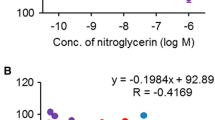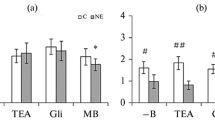Summary
We studied the effects of cyclosporin dissolved in the vehicle used as an intravenous preparation, namely, cremophor EL, and cremophor alone on the basal coronary flow plus endothelial function and vascular smooth muscle response by examining their influence on 5-hydroxytryptamine (5-HT) and nitroglycerine (GTN) induced changes in coronary flow in the isolated rat heart. A total of 72 rat hearts were perfused with a modified Langendorf preparation. There was a 12.8±3% reduction in the basal coronary flow after 60 minutes of perfusion with the drug-free buffer (p=ns). A dose of 50 ng/ml of cremophor or cyclosporin gave a similar reduction in the flow (cremophor 9.2±0.7%, cyclosporin 12.7±2%). However, at higher concentrations cremophor caused dose-dependent coronary vasodilation, while cyclosporin had the opposite effect. The maximum effect after 1000 ng/ml of cyclosporin was a 48.7±0.6% decrease, and after an equivalent dose of cremophor a 24.8±2.2% increase in the flow. The vasodilatory response to 5-HT and GTN remained unchanged after 60 minutes of perfusion with the drug-free buffer (5-HT, before 33.3±2.5%, after 37.7±4.2%; GTN, before 34.3±2.5%, after 33.7±1.5%). A period of 60 minutes of perfusion with 500 ng/ml and 1000 ng/ml of cremophor caused a significant reduction in the 5-HT response without an appreciable change in the effect of GTN (500 ng/ml—5-HT, before 29.9±0.9% after 10.7±3.7%; GTN, before 32.3±1.9% after 31.8±3.5%; 1000 ng/ml—5-HT, before 29.7±0.6%, after 12.3±2.7%; GTN, before 33.3±2.8%, after 32.7±1.4%; p<0.001). The same concentration of cyclosporin not only reduced the 5-HT response but also reduced the vasodilation induced by GTN (500 ng/ml—5-HT, before 35.3±3.7%, after 1.6±5%; GTN, before 30.8±1.5%, after 11.2±2.7%; 1000 ng/ml—5-HT, before 32.8±1.9%, after -32.3±1.1%; GTN, before 35.7±0.8%, after 10.0±1.3%). We conclude that cremophor EL causes endothelial dysfunction in the isolated rat heart, and this effect may be aggravated by cyclosporin dissolved in cremophor. Cyclosporin with cremophor also leads to injury to vascular smooth muscle. The direct effect of cremophor is to cause coronary vasodilation, while cyclosporin causes dose-dependent coronary vasoconstriction.
Similar content being viewed by others
References
Hamilton DV, Carmichael DJS, Evans DB, Caine BY. Hypertension in renal transplant recipients on cyclosporin A and corticosteroids and azathioprine. Transplant Proc 1982;14:597–600.
Bellet M, Cabrol C, Sassano P, et al. Systemic hypertension after cardiac transplantation: Effect of cyclosporin on the renin-angiotensin-aldosterone system. Am J Cardiol 1985;56:927–937.
Bennett WM, Porter GA. Cyclosporin-associated hypertension. Am J Med 1988;85:131–133.
Shulman H, Striker G, Degg H, et al. Nephrotoxicity of cyclosporin A after allogenic bone marrow transplantation. N Engl J Med 1981;305:1392–1395.
Sweny P, Hooper J, Gross M, Varghese Z. Nephrotoxicity of cyclosporin A. Lancet 1981;1:663.
Bennett WM, Pulliam JP. Cyclosporin nephrotoxicity. Ann Intern Med 1983;99:851–854.
Vanrenterghem YL, Roels T, Lerut J, et al. Thromboembolic complications and haemostatic changes in cyclosporintreated cadaveric kidney allograft recipients. Lancet 1985;2:999.
Zoja C, Furci L, Ghilardi F, et al. Cyclosporine-induced endothelial cell injury. Lab Invest 1986;55:455–462.
Shulman H, Striker G, Joachim Deeg H, et al. Nephrotoxicity of cyclosporin A after allogeneic marrow transplantation. N Engl J Med 1981;305:1392–1395.
Bergstrand A, Bohmann SO, Farnsworth A, et al. Renal histopathology in kidney transplant recipients immunosuppressed with cyclosporin A. Clin Nephrol 1985;24:107–119.
Bossaller C, Förstermann U, Hertel R, et al. Cyclosporin A inhibits endothelium-dependent vasodilation and vascular prostacyclin production. Eur J Pharmacol 1989;165:165–169.
Dinh Xuan AT, Fan TPD, Higenbottam TW, et al. Cyclosporin in vitro reduces endothelium-dependent relaxation to acetylcholine but does not affect relaxation to nitrovasodilators. Transplantation Proc 1990;22:1723–1725.
Besarab A, Jarrell BE, Hirsch S, et al. Use of the isolated perfused kidney model to assess the acute pharmacologic effects of cyclosporin and its vehicle, cremophor EL. Transplantation 1987;44:195–201.
Kone BC, Racusen LC, Whelton A, Sole K. Acute renal failure produced by combining cyclosporine and brief renal ischemia in the Munic-Wistar rat. Clin Nephrol 1986;25 (Suppl 1):S171-S173.
Howrie DL, et al. Anaphylactic reactions associated with parenteral cyclosporin use: Possible role of cremophor E. Drug Intell Clin Pharm 1985;19:425.
Blaauw AAM, Leunissen KML, Cheriex EC, et al. Disappearance of pulmonary capillary leak syndrome when intravenous cyclosporine is replaced by oral cyclosporine. Transplantation 1987;43:758–759.
Krebs HA, Hanseleit K. Untersuchungen uber die Harnstoffbildung im Tierkorper. Hoppe-Seyler's Zeits Physiol Chemie 1932;210:33–66.
Langendorf O. Untersuchungen am uberlebender Saugertierherzen. Pfluger's Archiv 1935;61:291–332.
Stiller CR, Keown PA. Cyclosporin therapy in perspective. In: Morris PJ, Tilney NL, eds. Progress in transplantation, Vol. 1. New York: Churchill Livingston, 1984:11–45.
Bassenge E, Busse R. Endothelial modulation of coronary tone. Prog Cardiovasc Dis 1988;30:349–480.
Mankad PS, Chester AH, Yacoub MH. 5-Hydroxytryptamine mediates endothelial dependent coronary vasodilation in the isolated rat heart by the release of nitric oxide. Cardiovasc Res 1990;25:244–248.
Saldanha C, Hearse DJ. Coronary vascular responsiveness to 5-hydroxytryptamine before and after infusion of hyperkalemic crystalloid cardioplegic solution in the rat heart. Possible evidence of endothelial damage. J Thorac Cardiovasc Surg 1989;98:783–787.
Lamping KG, Marcus ML, Dole WP. Removal of the endothelium potentiates canine large coronary artery constrictor responses to 5-hydroxytryptamine in vivo. Circ Res 1985;57:46–54.
Luscher TF. Endothelial vasoactive subtances and cardiovascular disease. Basel: S. Karger, 1988:1–130.
Radomski MW, Palmer RMJ, Moncada S. The antiaggregatory properties of vascular endothelium: Interaction between prostacyclin and nitric oxide. Br J Pharmacol 1987;92:639–646.
Lau DCW, Wong KL, Hwang WS. Cyclosporine toxicity on cultured rat microvascular endothelial cells. Kidney Int 1989;35:604–613.
Kushwaha S, Bustami M, Crossman D, et al. Preserved endothelial dependent response to intracoronary substance P in cardiac transplant recipients. J Am Coll Cardiol, in press.
O'Neil GS, Chester AH, Rose M, et al. The effect of cyclosporin A on the release of endothelium derived relaxing factor from isolated human epicardial coronary arteries. Transplantation 1991;51:736–738.
Rubanyi GM, Vanhoutte PM. Nature of endothelium-derived relaxing factor: Are there two relaxing mediators? Circ Res 1987;61(Suppl II):61–67.
Griffith TM, Lewis MJ, Newby AC, Henderson AH. Endothelium-derived relaxing factor. J Am Coll Cardiol 1988;12:797–806.
Mihatsch MJ, Thiel G, Oberholzer M, et al. Morphological findings in kidney transplants after treatment with cyclosporin. Transplant Proc 1983;15(Suppl 1):2821–2836.
Rego A, Vargas R, Wroblewska B, et al. Attenuation of vascular relaxation and cyclic GMP responses by cyclosporin A. J Pharmacol Exp Ther 1990;252:165–170.
McKenzie N, Divineni R, Venzina W, et al. The effect of cyclosporine on organ blood flow. Transplant Proc 1985;17:1973–1975.
Lorenz W, Schmal A, Schult H, et al. Histamine release and hypotensive reactions in dogs by solubilizing agents and fatty acids: Analysis of various components in Cremophor EL and development of a compound with reduced toxicity. Agents Actions 1982;12:64–80.
Murray BM, Paller MS, Ferris TF. Effect of cyclosporin administration on renal hemodynamics in conscious rats. Kidney Int 1985;28:767–774.
Whitting PH, Thomson AW, Simpson JG. Cyclosporine: Toxicity, metabolism, and drug interactions—implications from animal studies. Transplant Proc 1985;17(Suppl 1):134–144.
Rossi NF, Churchill PC, McDonald FD, Ellis VR. Mechanism of cyclosporin A-induced renal vasoconstriction in the rat. J Pharmacol Exp Ther 1989;250:896–901.
Kawaguchi A, Goldman MH, Shapiro R, et al. Increase in urinary thromboxane B2 in rats caused by cyclosporin. Transplantation 1985;40:214–216.
Yanagisawa M, Kurihara H, Kimura S, et al. A novel potent vasoconstrictor peptide produced by vascular endothelial cells. Nature 1988;332:411–415.
Kon V, Sugiura M, Inagami T, et al. Role of endothelin in cyclosporin-induced glomerular dysfunction. Kidney Int 1990;37:1487–1491.
Macris MP, Frazier OH, Van Buren CT, et al. Improved immunosuppression for heart transplant patients using intravenous doses of cyclosporin. Transplantation 1989;47:311–314.
Author information
Authors and Affiliations
Rights and permissions
About this article
Cite this article
Mankad, P., Spatenka, J., Slavik, Z. et al. Acute effects of cyclosporin and cremophor EL on endothelial function and vascular smooth muscle in the isolated rat heart. Cardiovasc Drug Ther 6, 77–83 (1992). https://doi.org/10.1007/BF00050920
Issue Date:
DOI: https://doi.org/10.1007/BF00050920




